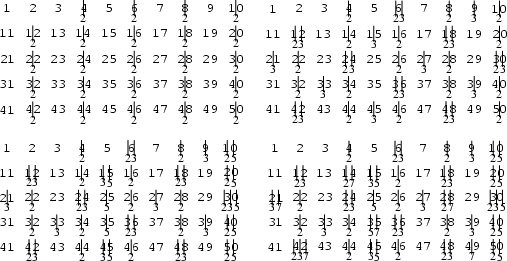|
|
|

An Algorithm for making tables of Primes. Sequentially write down the Integers from 2 to the
highest number ![]() you wish to include in the table. Cross out all numbers
you wish to include in the table. Cross out all numbers ![]() which are divisible by 2 (every second
number). Find the smallest remaining number
which are divisible by 2 (every second
number). Find the smallest remaining number ![]() . It is 3. So cross out all numbers
. It is 3. So cross out all numbers ![]() which are divisible by 3 (every
third number). Find the smallest remaining number
which are divisible by 3 (every
third number). Find the smallest remaining number ![]() . It is 5. So cross out all numbers
. It is 5. So cross out all numbers ![]() which are divisible by 5
(every fifth number).
which are divisible by 5
(every fifth number).
Continue until you have crossed out all numbers divisible by
![]() , where
, where
![]() is the Floor
Function. The numbers remaining are Prime. This procedure is illustrated in the above diagram which sieves up to 50, and
therefore crosses out Primes up to
is the Floor
Function. The numbers remaining are Prime. This procedure is illustrated in the above diagram which sieves up to 50, and
therefore crosses out Primes up to
![]() . If the procedure is then continued up to
. If the procedure is then continued up to ![]() , then the number of
cross-outs gives the number of distinct Prime factors of each number.
, then the number of
cross-outs gives the number of distinct Prime factors of each number.
References
Conway, J. H. and Guy, R. K. The Book of Numbers. New York: Springer-Verlag, pp. 127-130, 1996.
Ribenboim, P. The New Book of Prime Number Records. New York: Springer-Verlag, pp. 20-21, 1996.